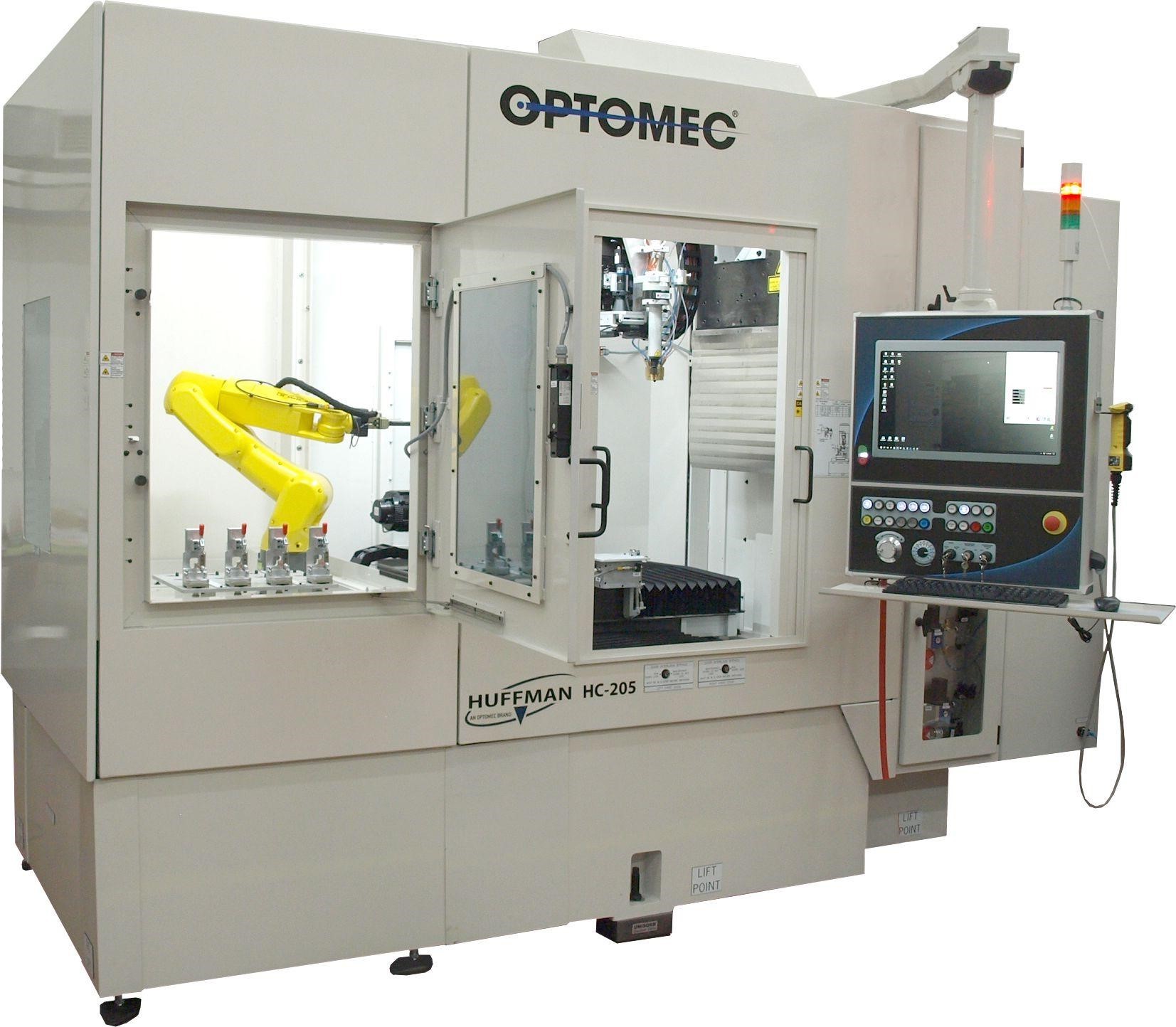Optomec, the New Mexico-based developers of Laser Engineered Net Shaping (LENS) and Aerosol Jet Printing (AJP) metal 3D printers, has introduced robotic automation to its Huffman line of production 3D Metal Additive Repair machines.
The company has combined its production laser cladders under the Huffman brand, with a Fanuc LRMate 200, a compact, six-axis industrial robot with the approximate size and reach of a human arm. The robotic integration is intended to automate the process of loading and unloading parts for high volume repair of turbine blades and vanes.
“Before automated laser cladding, the workflow for turbine blade repair was long and complicated,” explains Todd Lorich, Engineering Manager for Optomec’s Huffman line of automated laser cladders. Optomec optimized the flow dramatically by combining vision systems, software and laser cladding into one hardened, production-grade process step.”
“Now we are taking it one step further. Adding robotic part handling inside the machine really completes the automation for the process, freeing up the operator to add more value elsewhere in the workflow.”

Optomec LENS technology
Headquartered in Albuquerque, Optomec was founded in 1997 to deliver LENS 3D printing, a proprietary technology developed at Sandia Labs. Based on Directed Energy Deposition (DED) additive manufacturing, LENS uses a metal powdered feedstock that is blown through a nozzle and then melted on contact with a laser array to 3D print parts.
The capabilities of the LENS process makes it particularly suitable for adding new material to conformal surfaces and pre-fabricated components. As such, it has been used in a range of applications in maintenance, repair and overhaul (MRO), and reducing waste. LENS is also being used in a project led by the Navajo Technical University (NTU) to help NASA reach the moon in 2024.
Optomec provides LENS 3D printing technology as both a turnkey system, and an upgrade for existing multi-axis CNC milling machines. In late 2019, Optomec revealed that it had reached the milestone of delivering its 500th 3D printer worldwide, which also includes its AJP systems, the company’s technology for manufacturing electronics on both 2D and 3D substrates.

Acquisition of Huffman
Back in 2018, Optomec acquired Huffman LLC, a CNC and laser cladding machine supplier and service provider from Clover, South Carolina. Huffman was founded in 1961, and has extensive experience in supplying metal 3D printing systems for the additive repair of gas turbine components in the energy and aviation markets.
Of the deal, David Ramahi, president and CEO of Optomec commented at the time: “With the Huffman acquisition, we aim to expand the use of DED/LENS repair for the existing installed base of more than 100,000 gas turbines and engines.”
Huffman is now a brand operating under Optomec comprising a line of DED-based laser cladding systems designed to meet a wide range of additive manufacturing repair and hard facing applications, for turbine or engine components.
With the robotic integration of the Huffman line of laser cladders with the Fanuc LRMate 200, Optomec aims to automate the loading and unloading of parts into the chuck of the laser cladder. This will enable faster cycle times for the system, with trays and racks that contain a dozen or more components. As well as turbine blades and vanes, the potential for high volume repair can be used in a number of industrial applications. Examples include the repair of sealing surfaces of diesel engine components, or the addition of hardfacing materials to industrial valve parts.
The nominations for the 2020 3D Printing Industry Awards are now open. Who do you think should make the shortlists for this year’s show? Have your say now.
Subscribe to the 3D Printing Industry newsletter for the latest news in additive manufacturing. You can also stay connected by following us on Twitter and liking us on Facebook.
Looking for a career in additive manufacturing? Visit 3D Printing Jobs for a selection of roles in the industry.
Featured image shows automated laser cladding process. Image via Optomec.


